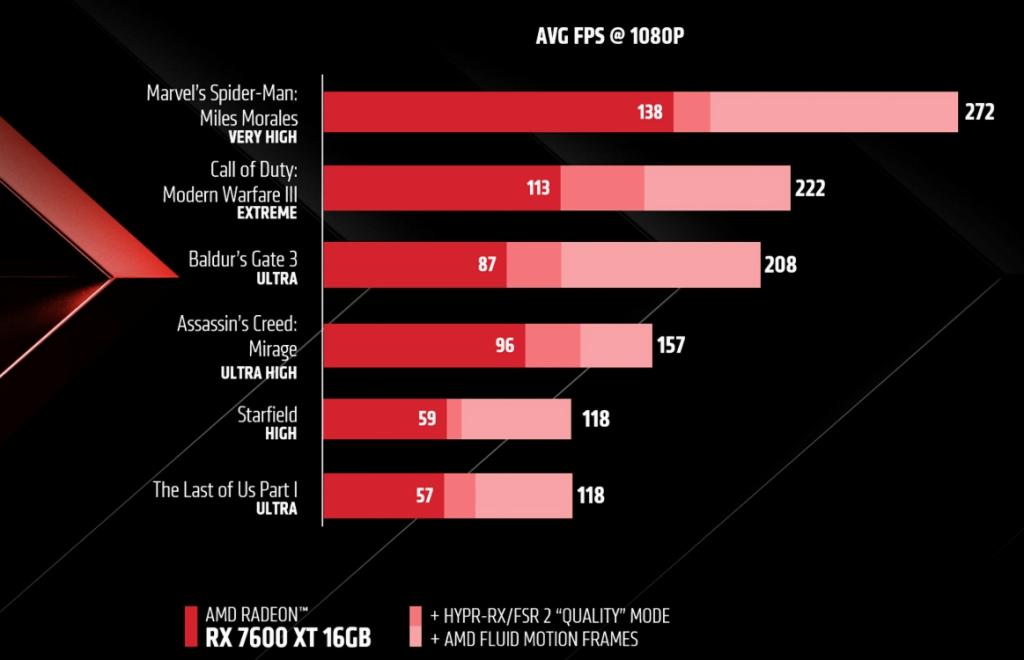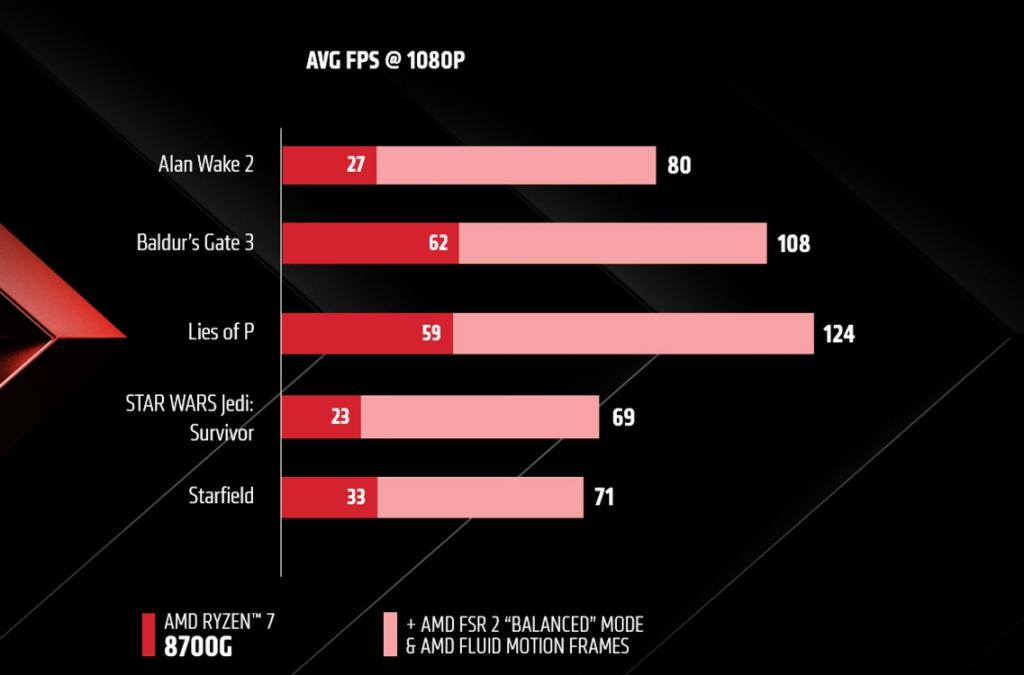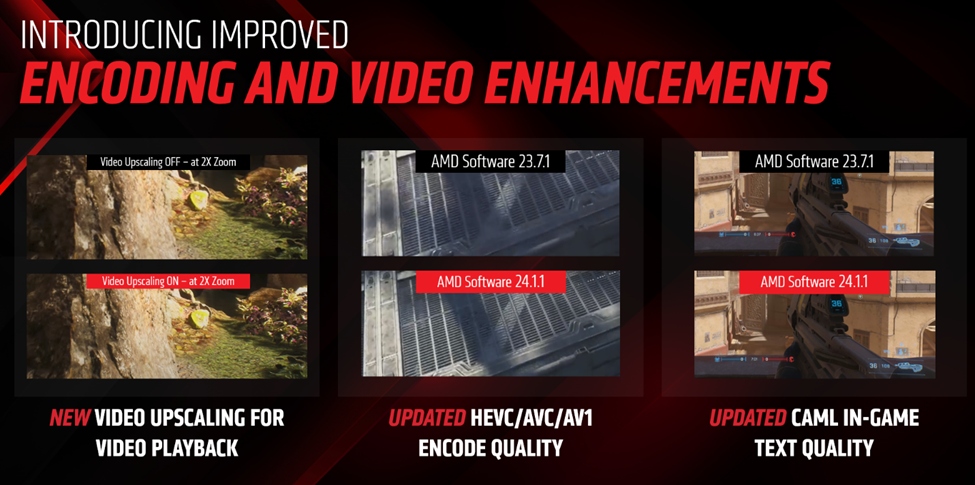
- The first stable driver for AFMF is now out.
- The new driver will let gamers enable AI frame generation across any DX11/DX12 game.
- AMD has also released Video Upscaling to upscale video playback in apps like Google Chrome. AFMF is supported on RDNA 2 and RDNA 3 GPUs.
AMD has just released the new Adrenalin Edition 24.1.1 drivers. These newest GPU drivers have several new features. However, the most notable one is the support for AFMF finally being added. Also called AMD Fluid Motion Frames, it is an AI frame generation technology that can essentially double your frames in-game.
These are not real frames but AI-generated frames inserted into your gameplay. The FPS improvement, as noted by AMD, is 97% on average. This was tested on “select titles at 1080p resolution”, where FSR Quality was also enabled.
AMD used the newly launched RX 7600 XT 16GB GPU to measure this boost given by enabling AFMF. Below, AMD has provided gaming benchmarks showing the performance improvement thanks to this tech.

AFMF can be enabled for any DX11 or DX12 game through Radeon Settings. The experience varies across games, but yes, the tech works and almost double the FPS in every game we have tested so far. Since then, AMD has reportedly taken feedback from gamers during the preview driver/beta stage of AFMF to improve upon the AI-based frame-boosting technology.
But, there are recommendations by AMD before enabling AFMF. Your game should be in full-screen mode, with Vsync being disabled. You should also turn on Radeon Anti-Lag for minimized input latency in your AFMF/FSR 3-enabled gaming experiences. Plus, according to the company, at least 60 FPS (produced without frame generation) is recommended before enabling AFMF.
AMD has even said that Fluid Motion Frames will be “giving you the upper edge against opponents.” In this blog post, the AFMF tech has been touted for competitive games like Valorant, too. However, frame generation tech also increases latency. AMD says “additional latency” could be introduced, and AFMF tech “may not offer the optimal experience for fast-paced competitive titles.”
AMD Fluid Motion Frames (AFMF): Supported GPUs
AMD AFMF AI Frame Generation technology is exclusive to AMD graphics cards. Remember that if a game natively has FSR 3 support instead, it should be used instead of AFMF. Below are all the AMD graphics cards which support AFMF:
- Radeon RX 7000 Series:
- RX 7900 XTX, 7900 XT, 7800 XT, 7700 XT, 7600 XT, and 7600.
- Radeon RX 6000 Series:
- RX 6400, 6500 XT, 6600, 6600 XT, 6650 XT, 6700, 6700 XT, 6750 XT, 6800, 6800 XT, 6900 XT, 6950 XT.
- Radeon 700M Series:
- Includes the latest Ryzen 8000G APUs and many other AMD laptop GPUs, such as RX 7900M.
As we said, you can easily find the AFMF option in Radeon settings to enable it. There is also a hotkey to toggle it on/off. With a supported AFMF-enabled GPU, pressing Alt+Shift+G will enable the AI frame generation technology.
Ryzen 8000G APUs Also Support AMD Fluid Motion Frames (AFMF)
AMD’s new Ryzen 8000G processors have been released. These are APUs from AMD, so it is an all-in-one package to give users an option that is not just a traditional CPU. Ryzen 8000G processors won’t cost nearly as much as flagship processors of today.
However, they will offer an NPU, which is a neural processing unit for AI processing, similar to the one on Intel Core Ultra. Then, Ryzen 8000G also offers high-performance RDNA 3 GPU coupled with the latest Zen 4 CPU with varied core counts based on the processor variants.

Since the new APUs feature RDNA 3, AFMF is also supported on these. At this point, AI frame generation technology isn’t just for traditional dedicated graphics cards. AMD has already implemented it for this all-in-one APU processor, which delivers decent gaming performance in today’s games without requiring a dedicated GPU. Hopefully, we will see AFMF support on Steam Deck 2 as well.
AMD Fluid Motion Frames (AFMF) vs FidelityFX 3 (FSR 3): Explained
If you are wondering about the difference between FSR 3 and the AFMF, let me elaborate. Both are technologies for AI frame generation made by AMD. The framework is also open-source. AFMF is a driver-level implementation of AI frame generation and can be enabled in Radeon Settings. Grand Theft Auto V, for example, does not support any frame generation technology. But you can easily add it to Radeon Settings, enabling AFMF on the game to get better frame rates. We have shown this below.

FSR 3 is a game engine-based implementation. So, FSR 3 is better and baked into the game rather than being present on the driver level. The option for FSR 3 is available in the graphics settings of the actual PC games you play.
Many new games, such as Avatar: Frontiers of Pandora and Immortals of Aveum, let you enable FSR 3 AI frame generation for any GPU. I tested it with an RTX 3070 Ti and got extremely smooth frame rates with very little input delay.
AFMF and FSR 3 have both impressed me quite a lot. Given that the RTX 30 Series does not support any frame generation technology from Nvidia, AMD FSR 3 is one of the best features in PC gaming right now.
With AFMF, things get better as AMD GPU users can enable frame generation across all sorts of games. Nvidia’s DLSS 3 can only be enabled on RTX 40 Series GPUs, starting with the RTX 4060, in supported games.
New Driver Also Includes AMD Video Upscaling
In addition to AFMF, another new feature in the graphics driver is AMD Video Upscaling. This is similar to Nvidia’s RTX VSR. With AMD Video Upscaling, users of RDNA 3 architecture-based RX 7000 Series GPUs can upscale the resolution of day-to-day video playback.

Windows Media Player, Google Chrome, and Microsoft Edge are mentioned to support AMD Video Upscslaing. So, all your daily content consumption can look better if you enable the new AMD Video Upscaling technology. According to AMD, with the new driver, users can open the Graphics Tab in Radeon Settings and turn the feature on.
What are your thoughts on AMD AFMF? Will you be enabling it during your gaming experiences? Also, do you think it is fine for competitive gaming? Let us know in the comments below!










